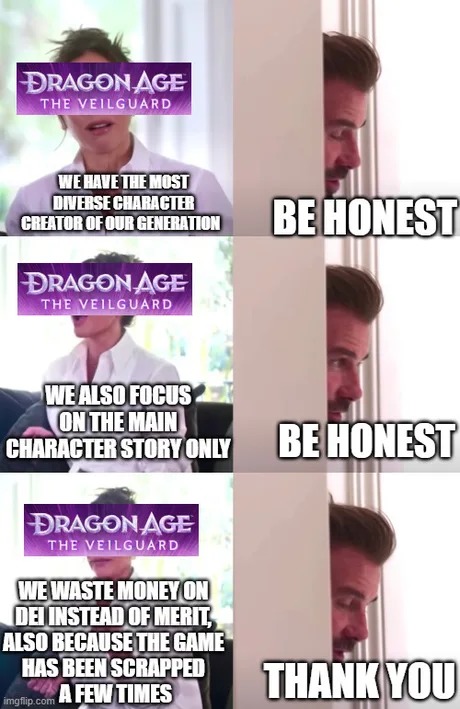LectureMaster
Gold Member

Dragon Age: The Veilguard Is at War With Itself - IGN
Dragon Age: The Veilguard is awkwardly in conflict with itself, torn into pieces that reflect a sequel to a decade-old RPG and a fresh beginning with no ties to what came before.
Actually a rather lengthy article criticizing the game. This guy Matt Purslow sounds more like a OG fan of the series rather a progressive agent. Here are some snippets:
While I’m nowhere near the 100-hour mark myself, that line is so far proving true – not a single character has mentioned The Veilguard. My team of D&D archetype oddballs may collectively be known as such in all the marketing, online articles, and the physical box itself, but within the world of Thedas they’re none the wiser. Imagine Tony Stark and Steve Rogers having no idea the world called them Avengers… that’s how odd it is.
Many aspects of The Veilguard point to it being something of a soft reset or even spin-off from the main Dragon Age series. Set in the northern Tevinter region, it leaves behind the saga’s original southern home of Ferelden, along with all its characters and politics. Dragon Age has always started afresh with each new game as, unlike Mass Effect, there’s no persistent protagonist across the series as each instalment tells a brand new story. The shift to Tevinter is perfectly in keeping with Dragon Age’s history, then, but The Veilguard isn’t a typical Dragon Age game. It is its first direct sequel – a continuation of Dragon Age: Inquisition, which dedicated its post-credits and Trespasser DLC to setting up Solas as the villainous Dread Wolf. And this is where it all starts to feel a little messy.
So much of The Veilguard is dedicated to Solas. Its opening sees him performing a dangerous god-unleashing ritual, and the world is littered with quests that explore his history and relationship with those dark deities. There may be no mention of the word “Veilguard” anywhere, but everyone is talking about the Dread Wolf. Why isn’t that the name of the game again?
The Veilguard crew all appear to be likeable people, but it feels as if I’m being blocked from forging true bonds with them. That especially goes for Varric. What is arguably Dragon Age’s best-ever character has been imprisoned in his bedroom, consigned to spouting incidental dialogue that you can’t engage with. His sidelining is yet another example of The Veilguard’s uneasy relationship with its predecessor, but unfortunately the frustrating treatment of its new cast means it’s also difficult to fully embrace the story’s fresh faces.
The overall result is that Dragon Age: The Veilguard isn’t the golden era BioWare game that I had hoped it would be. Torn between continuing its traditional role-playing legacy and starting afresh as a modern action RPG, the end result is an awkward sequel trapped in a cage made of reboot ideas. After years and years of faltered steps I understand why BioWare landed on this particular, very mainstream AAA formula, but I wish it had been inspired by the undying mass popularity of The Witcher 3 – a full-on nerdy RPG – rather than veer closer to Sony’s palatable RPG-ish approach for modern God of War. But that ill-defined shape is often what uneasy development cycles get you. Thankfully The Veilguard’s launch has seemingly gone well for EA and BioWare, which hopefully means Dragon Age will continue. Let’s just hope next time it’s not just the name that’s got a bit of Baldur’s Gate in it.



